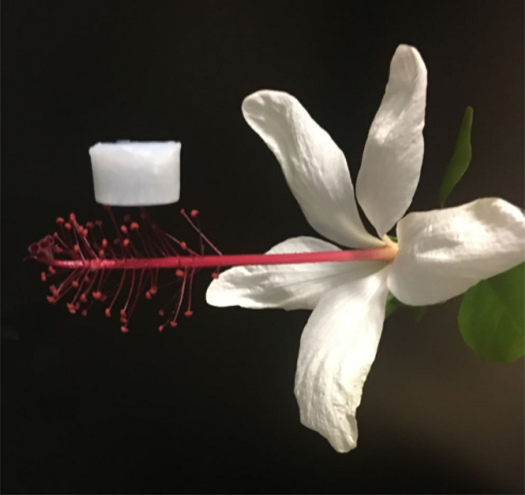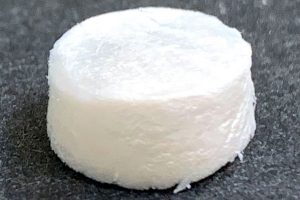 |
| February 26, 2019 | Volume 15 Issue 08 |
Designfax weekly eMagazine
Archives
Partners
Manufacturing Center
Product Spotlight
Modern Applications News
Metalworking Ideas For
Today's Job Shops
Tooling and Production
Strategies for large
metalworking plants
New ultra-lightweight ceramic material can better withstand extremes
A UCLA-led research team has created a new type of aerogel that can better endure extremely hot conditions and big swings in temperature. The new material, based on dynamic nanoscale technology, contracts when compressed or heated, which is the opposite of most materials.
University of California, Los Angeles (UCLA) researchers and collaborators at eight other research institutions have created an extremely light, very durable ceramic aerogel. The material could be used for applications like insulating spacecraft, because it can withstand the intense heat and severe temperature changes that space missions endure.
Ceramic aerogels have been used to insulate industrial equipment since the 1990s, and they have been used to insulate scientific equipment on NASA's Mars rover missions. But the new version is much more durable after exposure to extreme heat and repeated temperature spikes, and much lighter. Its unique atomic composition and microscopic structure also make it unusually elastic.

The new ceramic aerogel is so light, it can sit on a flower without damaging it.
When it's heated, the material contracts rather than expanding like other ceramics do. It also contracts perpendicularly to the direction that it's compressed -- imagine pressing a tennis ball on a table and having the center of the ball move inward rather than expanding out -- the opposite of how most materials react when compressed. As a result, the material is far more flexible and less brittle than current state-of-the-art ceramic aerogels: It can be compressed to 5 percent of its original volume and fully recover, while other existing aerogels can be compressed to only about 20 percent and then fully recover.
The research, which was published Feb. 14, 2019, in Science, was led by Xiangfeng Duan, a UCLA professor of chemistry and biochemistry; Yu Huang, a UCLA professor of materials science and engineering; and Hui Li of Harbin Institute of Technology, China. The study's first authors are Xiang Xu, a visiting postdoctoral fellow in chemistry at UCLA from Harbin Institute of Technology; Qiangqiang Zhang of Lanzhou University; and Menglong Hao of UC Berkeley and Southeast University.
Other members of the research team were from UC Berkeley; Purdue University; Lawrence Berkeley National Laboratory; Hunan University, China; Lanzhou University, China; and King Saud University, Saudi Arabia.

This sample of the new ceramic aerogel is about the size of a breath mint.
Despite the fact that more than 99 percent of their volume is air, aerogels are solid and structurally very strong for their weight. They can be made from many types of materials, including ceramics, carbon, or metal oxides. Compared with other insulators, ceramic-based aerogels are superior in blocking extreme temperatures, and they have ultra-low density and are highly resistant to fire and corrosion -- all qualities that lend themselves well to reusable spacecraft.
But current ceramic aerogels are highly brittle and tend to fracture after repeated exposure to extreme heat and dramatic temperature swings, both of which are common in space travel.
The new material is made of thin layers of boron nitride, a ceramic, with atoms that are connected in hexagon patterns, like chicken wire.
In the UCLA-led research, it withstood conditions that would typically fracture other aerogels. It stood up to hundreds of exposures to sudden and extreme temperature spikes when the engineers raised and lowered the temperature in a testing container between -198 degrees C and 900 degrees above zero over just a few seconds. In another test, it lost less than 1 percent of its mechanical strength after being stored for one week at 1,400 C.
"The key to the durability of our new ceramic aerogel is its unique architecture," Duan said. "Its innate flexibility helps it take the pounding from extreme heat and temperature shocks that would cause other ceramic aerogels to fail."
Ordinary ceramic materials usually expand when heated and contract when they are cooled. Over time, those repeated temperature changes can lead those materials to fracture and ultimately fail. The new aerogel was designed to be more durable by doing just the opposite -- it contracts rather than expands when heated.
In addition, the aerogel's ability to contract perpendicularly to the direction that it's being compressed -- like the tennis ball example -- help it survive repeated and rapid temperature changes. (That property is known as a negative Poisson's ratio.) It also has interior "walls" that are reinforced with a double-pane structure, which cuts down the material's weight while increasing its insulating abilities.
Duan said the process researchers developed to make the new aerogel also could be adapted to make other ultra-lightweight materials.
"Those materials could be useful for thermal insulation in spacecraft, automobiles, or other specialized equipment," he said. "They could also be useful for thermal energy storage, catalysis, or filtration."
The research was partly supported by grants from the National Science Foundation.
Source: UCLA
Published February 2019
Rate this article
View our terms of use and privacy policy
